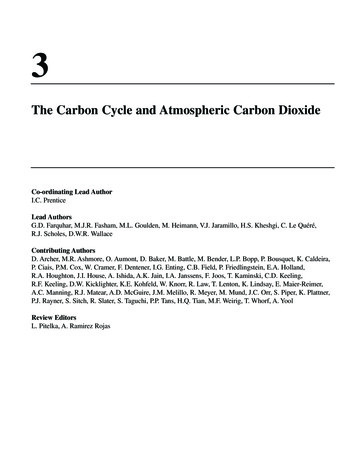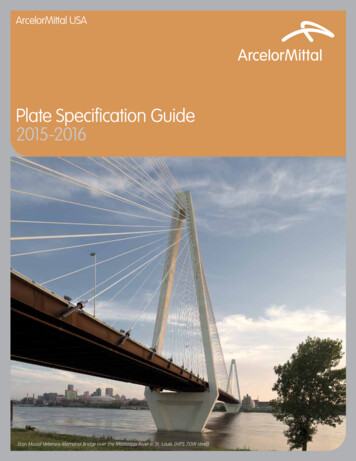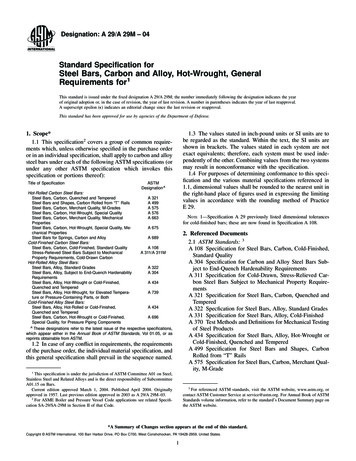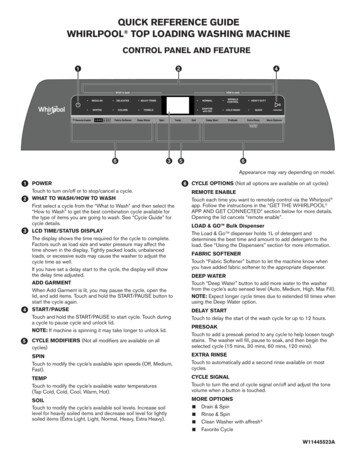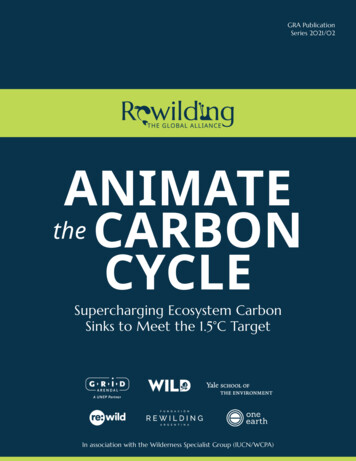
Transcription
1GRA PublicationSeries 2021/02ANIMATEthe CARBONCYCLESupercharging Ecosystem CarbonSinks to Meet the 1.5 C TargetIn association with theGlobalWildernessSpecialistRewildingAlliance Group obal.org
2Global Rewilding Alliancewww.rewildingglobal.org info@rewildingglobal.org
3PUBLICATION INFORMATION29 October 2021This document may be reproduced wholly or in part. Please include the attribution:Supercharging the Carbon Cycle; Global Rewilding Alliance Publication Series (2021/02).Produced by the Secretariat of the Global Rewilding Alliance (GRA), supported by the WILDFoundation, Re:wild, and OneEarth.The GRA is a network of rewilding practitioners and messengers based on the Global Charterfor Rewilding the Earth (a product of planning for the 11th World Wilderness Congress, 2020).Special acknowledgement goes to Magnus Sylvén and Karl Wagner (Co-Directors of the GRA)and Dr Oswald Schmitz (Yale School of The al.orgGlobal Charter for Rewilding the Earth, wild11.org/charter.Animating the Carbon Cycle, for more information.The Global Rewilding Alliance, founded byGlobal Rewilding Alliancewww.rewildingglobal.org info@rewildingglobal.org
4ANIMATE THE CARBON CYCLESupercharging Ecosystem Carbon Sinksto Meet the 1.5 C TargetThe world community increasingly knows that the existential crisis of climate breakdown andspecies loss is holistic, affecting many sectors simultaneously and catastrophically, and canonly be solved by exploring and deploying solutions that address diverse issues and ionois to avoid catastrophe, creating opportunities for game-changing practice and behavior for amore enlightened and prosperous future.Gray Wolf, Credit: Stafan WidstrandThere is a critical bridge between biodiversity and climate that is increasingly recognized byscientists and civil society. It is that healthy populations of wild animal species can have a major- but currently underappreciated and undervalued - positive impact on carbon drawdown andstorage–o Indeedflo researcho iso nowo showingo thato byo bringingo wildlifeo backo too signiBcantflo nearohistoric levels, they have the potential to “supercharge climate mitigation”. This science iscalled: “Animating the Carbon Cycle.”Global Rewilding Alliancewww.rewildingglobal.org info@rewildingglobal.org
5“Animating the Carbon Cycle” (ACC) accounts for the role wild animals play in controlling carbonexchange between ecosystems and the atmosphere through their foraging, by redistributingseeds and nutrients over vast land- and seascapes, and by trampling and compacting soils andsediments. Through these various activities, animals can enhance the carbon density of massiveoCO oreleasingowildBresfloprotectoagainstopermafrosto thawingflo ando enhanceo soilo ando sedimento carbono retentiono througho inCuenceo onomicrobial processes and chemical –oThe Serengeti ecosystem has switchedfrom being a major carbon source toa sink following the restoration of thewildebeest population to their historiclevels. It now takes up between 1- 8million tons (or 0.001 - 0.008 Gigatons,Gt) of carbon annually, which can makeaosigniBcantocontributionotoooffsettingothe combined annual carbon emissionsof Kenya and Tanzania from fossil fuelburning. Protecting trophic cascadesinvolving wolves, moose, and treesacross the North American borealregion can contribute to the processof 150 million tons (0.15 Gt) of carbontaken up annually, the equivalent of10% of United States' carbon emissionsfrom fossil fuel burning. Restoringforest elephants to historic levels inthe Congo basin could result in 85 million tons (0.085 Gt) of carbon taken up annually, theequivalent of France’s annual carbon emission from fossil fuel burning. Restoring the whalesto best current estimates of their historic pre-exploitation levels may have the potential to takeup 450 million tons (0.45 Gt) of ocean carbon annually corresponding to the annual emissionsof Russia – and more than entire Africa–o Despiteo overBshingflo theo biologicalo functionso ofoBshhas been estimated contribute approximately 1.65 billion (1.65 Gt) tons annually to the globalocean carbon cycle, making up about 16 percent of the total carbon that sinks below the ocean'supper layers. This corresponds to twice the CO2 emissions of the EU-27, with a huge potentialGlobal Rewilding Alliancewww.rewildingglobal.org info@rewildingglobal.org
ing biodiversity and climate mitigation via the ACC concept holds exciting and essentialpromise. Restoring/rewilding and conserving the functional role of vertebrate and invertebratespecies can be a game changer by magnifying carbon uptake by 1.5 to 12.5 times (or perhapseven more!) across the world’s terrestrial, freshwater and marine ecosystems.We don’t need yet another warning, as obvious and important as they are, because we all oa solution. The irrefutable truth is that if we treat nature as our partner – that means protectingintact natural systems that are the very foundation of carbon storage, and restoring /rewildingkey areas to functionality – nature will work with us and the potential of our partnership isexponential. Combining nature-based solutions with an array of other technologies andchanged human behaviors can revolutionize our results to change the trajectory of combatclimate change.Weo repeato theo Brsto priorityo ofo ao simpleo solution‰o preservingo stillintacto natureo ando restoringofunctional ecosystems – rewilding! - at large scale. But it’s urgent: only “2.8% of the land surfacecould be considered functionally intact". The situation for our seas is hardly any better.Integrating the concept of “Animating the Carbon Cycle” into nature-based climate solutionswill allow nature, climate and people to prosper. Carbon is managed, species are saved, andIndigenous Peoples who steward many of these intact areas will be supported and their culturesstrengthened.“Animating the Carbon Cycle” is the critical, missing link between biodiversity and climatechange.We, the signing parties, are a group of civil society organizations, scientists and supportingindividuals committed to drive forward the concept of Animating the Carbon Cycle, tomainstream it in the discussions and decision-making processes relating to climate andbiodiversity. We are prepared to share more information and practical methodologies toassure that this opportunity helps life on earth survive and thrive.Global Rewilding Alliancewww.rewildingglobal.org info@rewildingglobal.org
7Anish AndheriaPresident, Wildlife ConservationTrust, IndiaEmiliano isha B. AtwoodAssociate Professor, Departmentof Watershed Sciences andthe Ecology Center, Utah StateUniversity, USAChristopher DoughtyAssociate Professor, Schoolof Informatics, Computing,and Cyber Systems, NorthernArizona University, USAFabio BerzaghiMarieoSkłodowskaCurieoResearch Fellow, Laboratoryof Climate and EnvironmentalSciences - CEA, FranceYolan FriedmanCEO, Endangered Wildlife Trust,South AfricaPhoebe BarnardProfessor, CEO/ExecutiveDirector, Stable Planet Alliance,USAJedediah BrodieCraighead Chair ofConservation, Division ofBiological Sciences & WildlifeProgram, University of Montana,USAKarl BurkartCo-Founder & Deputy Director,One Earth, USAPeter CairnsExecutive Director, Scotland theBig PictureHeather CampbellCEOfloBushoHeritageoAustraliaRalph ChamiAssistant Director, FinancialPolicies Division, TheInternational Monetary Fund,USASamuel ChevallierCo-Founder & Director, ReWildAfrica, South AfricaJoris CromsigtAssociate Professor, Wildlife,Fish & Environmental Studies,Swedish University ofAgricultural SciencesJohn DavisExecutive Director, RewildingInstitute, USAArend de HaasExecutive Board Member,True Nature Foundation, TheNetherlandsRobert DebusChair, Great Eastern RangesInitiative, AustraliaConnel FullenkampProfessor of the Practice ofEconomics, Duke University, USAMark HalleCo-Founder, Better Nature,SwitzerlandPeter HarrisManaging Director, GRIDArendal, NorwayJodi HiltyPresident and Chief Scientist,Yellowstone to YukonConservation Initiative, USASofía HeinonenExecutive Director, RewildingArgentinaNathalie HilmiSenior Researcher / cientiBcoCenterPaul JepsonNature Recovery Lead, Ecosulis, UKSunday Berlioz KakpoPresident, SOS Biodiversity,BeninJon LeibowitzExecutive Director, NortheastWilderness Trust, USAShawn J. LerouxProfessor, Department ofBiology, Memorial University ofNewfoundland, CanadaJo RobertsCEO, Wilderness Foundation UKLucas RuzoCEO, Citzen Zoo, UKMicheli Ribeiro LuizExecutive Coordinator, InstitutoFelinos do Aguaí, BrazilAndrew MuirCEO, Wilderness FoundationAfricaSebastian Di MartinoConservation Director, RewildingArgentinaSteven LutzSenioroProgrammeoOgcerfloBlueoCarbon Lead, GRID-Arendal,NorwayVance G. MartinPresident, The WILD Foundation,USA; Wilderness FoundationGlobal (South Africa)Julia Marton-LefèvreMember of the BureauIntergovernmental SciencePolicy Platform on Biodiversityand Ecosystem Services (IPBES),GermanyVivek MenonFounder Trustee & ExecutiveDirector, Wildlife Trust of IndiaSteve MicklewrightCEO, Trees for Life, ScotlandRussell MittermeierChiefoConservationoOgcerfloRe:wild, USACarolina MorgadoExecutive Director, RewildingChileWerner MyburghCEO, Peace Parks Foundation,South AfricaShahid NaeemProfessor of Ecology,Department of Ecology,Evolution, and EnvironmentalBiology, Columbia University,USAShloka NathHeadooSustainabilityfloTataoTrusts, India, Acting CEO, IndiaClimate CollaborativeDinah NieburgCo-Founder & COO, Blue GreenFuture, USARoger OlssonActing Executive Director,Rewilding SwedenAndrew ParkerDirector, Conserve Global, UKChristoph PrombergerExecutive Director, CarpathiaEuropean Wilderness Reserve,RomaniaThomas LovejoyProfessor, EnvironmentalScience and Policy, GlobalBiodiversity Policy, ForestFragmentation, TropicalEcosystems, George MasonUniversity, USAJames WallaceChief Executive, Beaver Trust, UKJoe RomanPhD, Gund Institute forEnvironment, University ofVermont, USABittu SahgalEditor, Sanctuary Asia magazine& Founder, Sanctuary NatureFoundation, IndiaFrans SchepersManaging Director, RewildingEurope, The NetherlandsAlister ScottDirector, The One LeadershipProject, UKOswald SchmitzOastler Professor of Populationand Community Ecology, YaleSchool of the Environment, USAJan StannardFounding Trustee & Acting CEO,HealoRewildingfloUKMagnus SylvénCo-director, Global RewildingAlliance, USAKristine M. TompkinsCo-Founder & President,Tompkins Conservation, USAKarl WagnerCo-director, Global RewildingAlliance, USAChris WilmersProfessor, EnvironmentalStudies Department, Universityof California, USARebecca WrigleyCo-Founder & CEO, RewildingBritainBeatriz PadillaPresident, Fundación Biosferadel Anahuac, A.C. (FUNBA),MexicoStaffan Widstrand & MagnusLundgrenManaging Director & Director,Wild Wonders International,Sweden
CEO, Citzen Zoo, UK Micheli Ribeiro Luiz Executive Coordinator, Instituto Felinos do Aguaí, Brazil Andrew Muir CEO, Wilderness Foundation Africa Steven Lutz Senior Programme Officer, Blue Carbon Lead, GRID-Arendal, Norway Vance G. Martin President, The WILD Foundation, USA; Wildern

